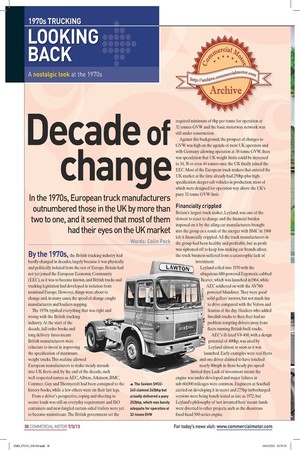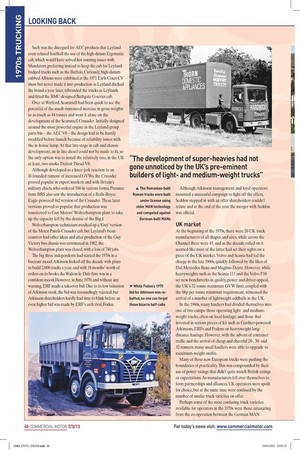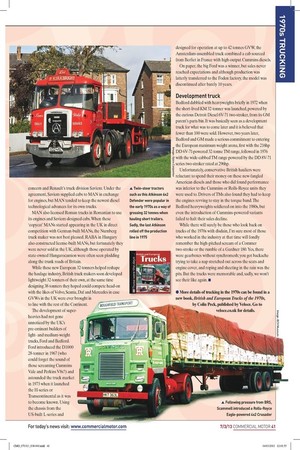El ecade of change In the 1970s, European truck manufacturers
Page 29

Page 31

Page 32

If you've noticed an error in this article please click here to report it so we can fix it.
outnumbered those in the UK by more than two to one, and it seemed that most of them had their eyes on the UK market Words: Colin Peck By the 1970s p the British trucking industry had hardly changed in decades, largely because it was physically and politically isolated from the rest of Europe. Britain had not yet joined the European Economic Community (EEC), as it was to become known, and British trucks and trucking legislation had developed in isolation from mainland Europe. However, things were about to change and, in many cases, the speed of change caught manufacturers and hauliers napping.
The 1970s typified everything that was right and wrong with the British trucking industry. At the start of the decade, full order books and long delivery times meant British manufacturers were reluctant to invest in improving the specification of maximumweight trucks. This malaise allowed European manufacturers to make steady inroads into UK fleets and, by the end of the decade, such well-respected names as AEC, Albion, Atkinson, BMC, Commer, Guy and Thornycroft had been consigned to the history books, while a few others were on their last legs.
From a driver's perspective, roping and sheeting to secure loads was still an everyday requirement and ISO containers and new-f angled curtain-sided trailers were yet to become mainstream. The British government set the required minimum of 6hp per tonne for operation at 32 tonnes GVVV and the basic motorway network was still under construction.
Against this background, the prospect of changes to GVVV was high on the agenda of most UK operators and with Germany allowing operation at 38-tonne GVVV, there was speculation that UK weight limits could be increased to 34,38 or even 44 tonnes once the UK finally joined the EEC. Most of the European truck makers that entered the UK market at the time already had 250hp-plus highspecification sleeper-cab vehicles in production, most of which were designed for operation way above the UK's puny 32-tonne GVVV limit.
Financially crippled Britain's largest truck maker, Leyland, was one of the slowest to react to change and the financial burden imposed on it by the ailing car manufacturers brought into the group as a result of the merger with BMC in 1968 left it financially crippled. All the truck manufacturers in the group had been healthy and profitable, but as profit was siphoned off to keep loss-making car brands afloat, the truck business suffered from a catastrophic lack of investment.
Leyland rolled into 1970 with the ubiquitous 680-powered Ergomatic-cabbed Beaver, which was launched in1964, while AEC soldiered on with the AV760powered Mandator. They were good solid gaffers' motors, but not much fun to drive compared with the Volvos and Scanias of the day. Hauliers who added Swedish trucks to their fleet had no problem tempting drivers away from fleets running British-built trucks.
AEC's ill-fated V8-400, with a design potential of 400hp, was axed by Leyland almost as soon as it was WVX 7-5877' launched. Early examples were real flyers and one driver claimed to have touched nearly 80mph in those heady pre-speed limited days. Lack of investment meant the engine was under-developed and major failures in sub-60,000 mileages were common. Engineers at Southall carried on developing it in secret and 275hp turbocharged versions were being bench-tested as late as 1972, but Leyland's philosophy of 'not invented here' meant funds were diverted to other projects, such as the disastrous fixed-head 500-series engine. Such was the disregard for AEC products that Leyland even refused Southall the use of the high-datum Ergomatic cab, which would have solved hot-running issues with Mandators, preferring instead to keep the cab for Leylandbadged trucks such as the Buffalo. Curiously, high-datumcabbed Albions were exhibited at the 1971 Earls Court CV show but never made it into production as Leyland ditched the brand a year later, rebranded the trucks as Leylands and fitted the BMC-designed Bathgate G-series cab.
Over at Watford, Scammell had been quick to see the potential of the much-rumoured increase in gross weights to as much as 44 tonnes and went it alone on the development of the Scammell Crusader. Initially designed around the most powerful engine in the Leyland group parts bin — the AEC V8 — the design had to be hastily modified before launch because of reliability issues with the in-house lump. At that late stage in cab and chassis development, an in-line diesel could not be made to fit, so the only option was to install the relatively rare, in the UK at least, two-stroke Detroit Diesel V8.
Although developed as a knee-jerk reaction to an ill-founded rumour of increased GVVVs, the Crusader proved popular in export markets and with Britain's military chiefs, who ordered 500 in various forms. Pressure from BRS also saw the introduction of a Rolls-Royce Eagle-powered 4x2 version of the Crusader. These later versions proved so popular that production was transferred to Guy Motors' Wolverhampton plant to take up the capacity left by the demise of the Big J.
Wolverhampton technicians mocked up a 'Guy' version of the Motor Panels Crusader cab, but Leyland's beancounters had other ideas and after production of the Guy Victory bus chassis was terminated in 1982, the Wolverhampton plant was closed, with a loss of 740 jobs.
The big three independents had started the 1970s in a buoyant mood. Atkinson kicked off the decade with plans to build 2,000 trucks a year, and with 18 months' worth of orders on its books, the Walton-le-Dale firm was in a confident mood. However, in June 1970, and without any warning, ERF made a takeover bid. Due to its low valuation of Atkinson stock, the bid was resoundingly rejected, but Atkinson shareholders hardly had time to blink before an even higher bid was made by ERF's arch rival, Foden. UK market At the beginning of the 1970s, there were 20 UK truck manufacturers of all shapes and sizes, while across the Channel there were 45, and as the decade rolled on it seemed like most of the latter had set their sights on a piece of the UK market. Volvo and Scania had led the charge in the late 1960s, quickly followed by the likes of Daf, Mercedes-Benz and Magirus-Deutz. However, while heavyweights such as the Scania 111 and the Volvo F10 set new benchmarks in quality, power and driver-appeal, the UK's 32-tonne maximum GVVV limit, coupled with the 6hp per tonne minimum requirement, witnessed the arrival of a number of lightweight oddballs in the UK.
In the 1960s, many hauliers had divided themselves into one of two camps: those operating lightand mediumweight trucks, often on local haulage, and those that invested in serious pieces of kit such as Gardner-powered Atkinsons, ERFs and Fodens on heavyweight longdistance haulage. However, with the advent of container traffic and the arrival of cheap and cheerful 28-, 30and 32-tonners, many small hauliers were able to upgrade to maximum-weight outfits.
Many of these new European trucks were pushing the boundaries of practicality. This was compounded by their use of power ratings that didn't quite match British ratings or expectations. As manufacturers fell over themselves to form partnerships and alliances, UK operators were spoilt for choice, but at the same time were confused by the number of similar truck varieties on offer.
Perhaps some of the most confusing truck varieties available for operators in the 1970s were those emanating from the co-operation between the German MAN A The Romanian-built Although Atkinson management and loyal operators Roman trucks were built mounted a successful campaign to fight off the offers, under license using Seddon stepped in with an offer shareholders couldn't older MAN technology refuse and at the end of the year the merger with Seddon and competed against was official. concern and Renault's truck division Saviem. Under the agreement, Saviem supplied cabs to MAN in exchange for engines, but MAN tended to keep the newest diesel technological advances for its own trucks.
MAN also licensed Roman trucks in Romanian to use its engines and Saviem-designed cabs. When these 'copycat' MANs started appearing in the UK in direct competition with German-built MANs, the Nurnberg truck maker was not best pleased. RABA in Hungary also constructed license-built MANs, but fortunately they were never sold in the UK, although those operated by state-owned Hungarocamion were often seen plodding along the trunk roads of Britain.
While these new European 32-tonners helped reshape the haulage industry, British truck makers soon developed lightweight 32-tonners of their own, at the same time designing 38-tonners they hoped could compete head-on with the likes of Volvo, Scania, Daf and Mercedes in case GVVVs in the UK were ever brought in to line with the rest of the Continent.
The development of superheavies had not gone unnoticed by the UK's pre-eminent builders of lightand medium-weight trucks, Ford and Bedford. Ford introduced the D1000 28-tonner in 1967 (who could forget the sound of those screaming Cummins Vale and Perkins V8s?) and astounded the truck market in 1973 when it launched the H-series or Transcontinental as it was to become known. Using the chassis from the US-built L-series and (FIELDTPORT designed for operation at up to 42 tonnes GVVV, the Amsterdam-assembled truck combined a cab sourced from Berliet in France with high-output Cummins diesels.
On paper, the big Ford was a winner, but sales never reached expectations and although production was latterly transferred to the Foden factory, the model was discontinued after barely 10 years.
Development truck Bedford dabbled with heavyweights briefly in 1972 when the short-lived KM 32-tonner was launched, powered by the curious Detroit Diesel 6V-71 two-stroker, from its GM parent's parts bin. It was basically seen as a development truck for what was to come later and it is believed that fewer than 100 were sold. However, two years later, Bedford and GM made a serious commitment to entering the European maximum weight arena, first with the 216hp DD 6V-71-powered 32-tonne TM range, followed in 1976 5?
,T with the wide-cabbed TM range powered by the DD 8V-71 series two-stroker rated at 296hp.
Unfortunately, conservative British hauliers were reluctant to spend their money on these new-fangled American diesels and those who did found performance was inferior to the Cummins or Rolls-Royce units they were used to. Drivers of TMs also found they had to keep the engines revving to stay in the torque band. The Bedford heavyweights soldiered on into the 1980s, but even the introduction of Cummins-powered variants failed to halt their sales decline.
While there will surely be those who look back on trucks of the 1970s with disdain, I'm sure most of those who worked in the industry at that time will fondly remember the high-pitched scream of a Commer two-stroke or the rumble of a Gardner 180. Yes, there were gearboxes without synchromesh; you got backache trying to take a nap stretched out across the seats and engine cover, and roping and sheeting in the rain was the pits. But the trucks were memorable and, sadly, we won't see their like again. • • More details of trucking in the 1970s can be found in a new book, British and European Trucks of the 1970s, by Colin Peck, published by Veloce. Go to veloce.co.uk for details.







































